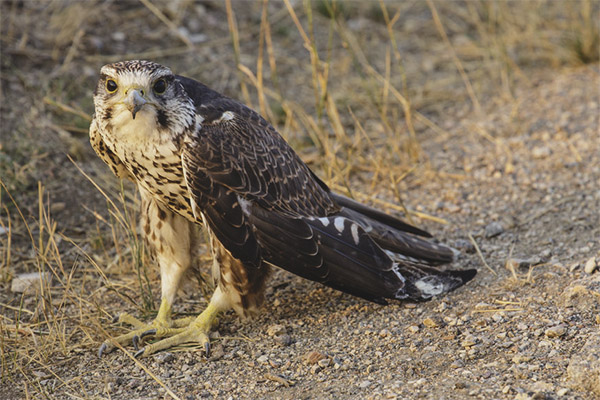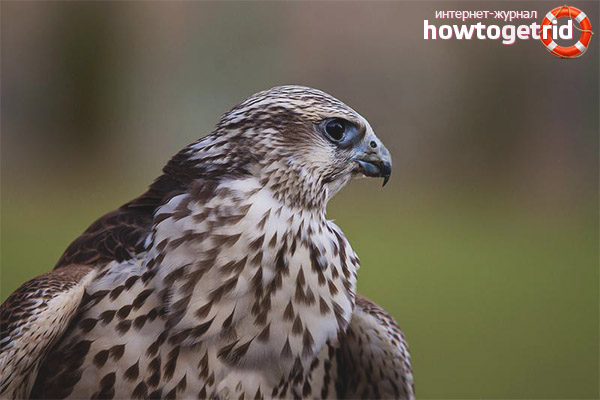The content of the article
Balabans are birds of prey. They are one of the most dangerous among all predatory birds. They belong to the falcon family. The species has several other names - ragor, itelgi. In addition, the name can be written as "Saker", and "Balaban." These are also 2 different names of this type. The word originated from Persia. The bird was given the name of Iranian falconers. The name of the species Itelga comes from Central Asia. The Slavs also called the bird - ragog. This word is taken from Polish and Hungarian.
Appearance
These birds have a powerful large body, in length it reaches 46-56 cm. The wingspan is from 1.1 to 1.3 m. The body weight is from 800 to 1350. The color may be different, depending on the species. The head is most often pale brown, there are mottled blotches. Their breasts are light, they can see light stripes along them. Balabana belly almost white.The feathers on the neck are light, on the back are brown stripes. The bill is bluish, and at the end has a black color.
Nutrition
Most often, their victims are gophers. Sometimes they catch pigeons or sparrows. Can eat marmots, hares. This is beneficial to local farmers, as the bird eats almost all harmful rodents.
They hunt in the steppe and forest-steppe areas, near the habitat. Prey looking out while sitting on a high tree or rock. During the hunt flies horizontally. He does not fall to the victim, as does most of the predatory birds.
Hunters use balabana as a trapping bird. He hunts well in the deserts.
Habitat
They live in the middle part of Asia. They live in Altai, as well as in Kazakhstan. They can also be found in the Krasnoyarsk Territory and Transbaikalia. Sometimes found in China and Afghanistan.
In winter, they fly to the territory of Ethiopia, to the western regions of China. The populations in the south do not fly away for the winter.
Kinds
- Common Balaban. The back has a brown color. On the sides are reddish feathers. The head is similar in color to the back, but somewhat lighter.Nadhvoste at balaban ordinary brown. “Mustaches” are viewed a little. The abdomen is light ocher, it has many spots of different shapes. Representatives of the species inhabit the forest-steppe. Habitat - Kazakhstan. The bird can be found throughout the territory, ranging from the Urals to Altai. Occasionally balabana can be seen also in the northern desert.
- Siberian. The back of the representatives of the species Siberian Balaban has a brownish color. It looks reddish spots that merge into stripes. The nadhvoste has a gray plumage. The color of the head is lighter than on the back. She has a reddish tone and dark specks. The abdomen is white with soft stripes. Lives in Altai, for the winter flies to Kazakhstan.
- Mongolian. These birds are distinguished by their brown color of the back, on which bright stripes are visible. It is inhabited by the Mongolian balaban in Tien Shan. The plumage on the head is light. On the pants and on the sides there is a pattern in the form of stripes and spots of dark color.
- Turkestan. This species has a bright color. They have a brick shade. On the back, plumage is brown and grayish. On the wings and back of the bird pattern in the form of stripes.Habitat Turkestan balabana - South Kazakhstan, Tien Shan and the territory of Karatau.
- Aralo-Caspian. In this species, the plumage on the back is brown, but dim. Figure light in the form of transverse stripes. The plumage in the region of the graytail is bluish. On the pants is also seen in the form of dark stripes. It lives in Mangyshlak.
- Altaic. These are big birds. Outwardly, they look like an ordinary balabana. Their color is dark or brown. On the back plumage is bluish. The same color in them and in the nadkhvostiya. The head is rather dark in comparison with other species, and on the sides there is a pattern in the form of stripes. The same pattern is on the pants of the bird.
Sex differences
In these birds, males and females are similar to each other in size and color.
Breeding
These are monogamous birds. Their marriage period begins in the second half of April. It is quite early compared to other birds.
Sometimes balabans can occupy an already finished nest, which has been abandoned by other birds. If you build it yourself, it has on a rock or hills. Some species may build nests in trees.They do not like to build nests on their own, therefore they are trying to find what they have already prepared. Often a couple finds several nests that have been abandoned by birds, and use them alternately.
The female lays on average about 3-5 eggs. They are red with slight dark spots. After a month or a little more, chicks appear. Most of the time, the female is sitting on the eggs. The male can sometimes replace it.
Chicks hatch in late May or early June. About a month later, young birds have time to learn how to fly over short distances. If they are attacked by the enemy, they fall on their backs and push their legs forward to defend themselves. About one and a half months parents take care of them, after which they can sometimes fly out.
At the age of 2 months, the Balaban chicks already fly perfectly. When they learn to fly, they start practicing hunting at the same time. Parents do not teach them. The chicks themselves are trying to attack the prey.
Young individuals wander closer to fall. Even before the departure for the winter, they fly away from the nesting site. Already at the age of the year they become sexually mature.
Individuals living in the wild can live for about 18–20 years.But there were cases when representatives of the species survived to 28 years or more.
Interesting Facts
- The number of species is declining and even threatened. Therefore, they are listed in the Red Book. Scientists in 2005 counted only about 8500 representatives of the species. If we consider that their habitat is very extensive, this number is extremely small. There is a threat of extinction. The main reason for which the population of Balaban is decreasing is human activity. Hunters trap small chicks to grow them and then use them for hunting. There were several black markets on the territory of the UAE, in which several thousand chicks annually sold. As a result, the number of representatives of the species has decreased dramatically. Another reason - the massive destruction of habitat. Many nests of these birds will collapse, they are infected. Many individuals die from pesticides that enter their bodies along with rodents that have been poisoned by humans. All these reasons are directly or indirectly related to human activities.
- Since the beginning of the 90s, a nursery was established in the reserve on the territory of the Lipetsk region “Galichya Gora”, in which they are actively breeding this species of birds.
- They do not hunt near their nests, but try to fly as far as possible. Smaller birds have noticed this, and enjoy this feature. They try to nest as close as possible to the nests of the balabana. In this way, they protect themselves and their homes from the Balaban itself and other predators that do not come close to its nests, which pose a danger to weak birds.
Video: Saker Falcon (Falco cherrug)












To send